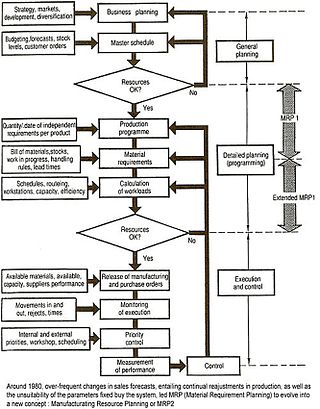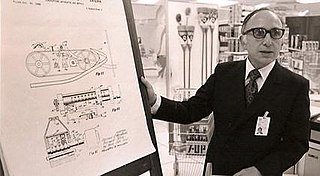
A cash register, sometimes called a till,cashbucker, or automated money handling system, is a mechanical or electronic device for registering and calculating transactions at a point of sale. It is usually attached to a drawer for storing cash and other valuables. A modern cash register is usually attached to a printer that can print out receipts for record-keeping purposes.

The Universal Product Code is a barcode symbology that is used worldwide for tracking trade items in stores.

A barcode or bar code is a method of representing data in a visual, machine-readable form. Initially, barcodes represented data by varying the widths, spacings and sizes of parallel lines. These barcodes, now commonly referred to as linear or one-dimensional (1D), can be scanned by special optical scanners, called barcode readers, of which there are several types.
Material requirements planning (MRP) is a production planning, scheduling, and inventory control system used to manage manufacturing processes. Most MRP systems are software-based, but it is possible to conduct MRP by hand as well.

A barcode reader or barcode scanner is an optical scanner that can read printed barcodes, decode the data contained in the barcode on a computer. Like a flatbed scanner, it consists of a light source, a lens, and a light sensor for translating optical impulses into electrical signals. Additionally, nearly all barcode readers contain decoder circuitry that can analyse the barcode's image data provided by the sensor and send the barcode's content to the scanner's output port.

Logistics automation is the application of computer software or automated machinery to improve the efficiency of logistics operations. Typically this refers to operations within a warehouse or distribution center, with broader tasks undertaken by supply chain engineering systems and enterprise resource planning systems.

The CueCat, styled :CueCat with a leading colon, is a cat-shaped handheld barcode reader that was given away free to Internet users starting in 2000 by the now-defunct Digital Convergence Corporation.
Hand Held Products was a US electronics manufacturer, established in 1981 in North Carolina. The company was a manufacturer of linear and 2D handheld barcode scanners based on imaging technology. Its product range included rugged mobile computers, image kiosks, and barcode verification devices. Its range of data collection and communication products were designed for mobile, on-site, and transaction processing applications. In 2007, the company was subsumed into the Honeywell Group.

Manufacturingresource planning is a method for the effective planning of all resources of a manufacturing company. Ideally, it addresses operational planning in units, financial planning, and has a simulation capability to answer "what-if" questions and is an extension of closed-loop MRP.

Intermec is a manufacturer and supplier of automated identification and data capture equipment, including barcode scanners, barcode printers, mobile computers, RFID systems, voice recognition systems, and life cycle services.

Norman Joseph Woodland was an American inventor and engineer, best known as one of the inventors of the barcode, for which he received a patent in October 1952. Later, employed by IBM, he developed the format which became the ubiquitous Universal Product Code (UPC) of product labeling and check-out stands.
EMS Technologies was an Atlanta-based company with approximately $290 million in annual sales revenue before its 2011 purchase by Honeywell International. EMS-T specialized in wireless, defense, and space communications systems.

SilverFast is the name of a family of software for image scanning and processing, including photos, documents and slides, developed by LaserSoft Imaging.
CipherLab is a company that designs, manufactures and markets automatic identification and data capture (AIDC) products and systems. The company's mobile computers and barcode scanners are integrated into the networks of government and logistics installations worldwide, as well as grocery, manufacturing, retail, distribution, agricultural and healthcare companies. Headquartered in Taipei, Taiwan with North American headquarters in Plano, Texas, and operations in Europe, the Middle East and Africa (EMEA), the Americas, Asia-Pacific and China, CipherLab is publicly traded on the Taiwan Stock Exchange.
Bernard Silver was an electrical engineer and early developer of barcode technology alongside Norman Joseph Woodland.
Inventory management software is a software system for tracking inventory levels, orders, sales and deliveries. It can also be used in the manufacturing industry to create a work order, bill of materials and other production-related documents. Companies use inventory management software to avoid product overstock and outages. It is a tool for organizing inventory data that before was generally stored in hard-copy form or in spreadsheets.

Digital Ocean, Inc., was founded in 1992 by Jeffery Alhom. Digital Ocean was a maker of wireless products from 1992 until it was disbanded in 1998.

Shlomo Touboul is an Israeli business executive and inventor who has founded several companies including Finjan and Shany Computers. He is currently the President and CEO of Illusive Networks, a startup from the Israel-based incubator, Team8.

The inoERP enterprise management system is an open-source Go and Flutter based Enterprise Resource Planning (ERP) application which can be used with MySQL, MariaDB or Oracle 12c databases. The objective of inoERP is to provide a dynamic pull based system where the demand /supply changes frequently and traditional planning systems are unable to provide a good inventory turn.
Barcode library or Barcode SDK is a software library that can be used to add barcode features to desktop, web, mobile or embedded applications. Barcode library presents sets of subroutines or objects which allow to create barcode images and put them on surfaces or recognize machine-encoded text / data from scanned or captured by camera images with embedded barcodes. The library can support two modes: generation and recognition mode, some libraries support barcode reading and writing in the same way, but some libraries support only one mode.












